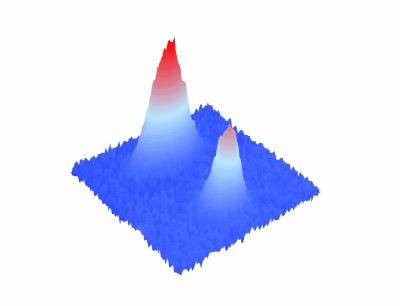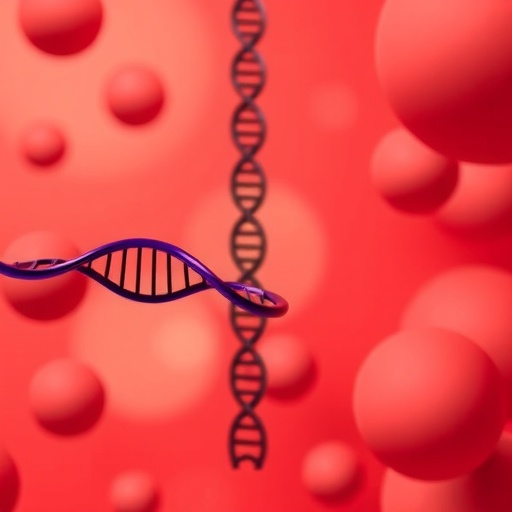
Credit: Ye Group/JILA
JILA researchers have developed tools to “turn on” quantum gases of ultracold molecules, gaining control of long-distance molecular interactions for potential applications such as encoding data for quantum computing and simulations.
The new scheme for nudging a molecular gas down to its lowest energy state, called quantum degeneracy, while suppressing chemical reactions that break up molecules finally makes it possible to explore exotic quantum states in which all the molecules interact with one another.
The research is described in the Dec. 10 issue of Nature. JILA is a joint institute of the National Institute of Standards and Technology (NIST) and the University of Colorado Boulder.
“Molecules are always celebrated for their long-range interactions, which can give rise to exotic quantum physics and novel control in quantum information science,” NIST/JILA Fellow Jun Ye said. “However, until now, nobody had figured out how to turn on these long-range interactions in a bulk gas.”
“Now, all this has changed. Our work showed for the first time that we can turn on an electric field to manipulate molecular interactions, get them to cool down further, and start to explore collective physics where all molecules are coupled to each other.”
The new work follows up on Ye’s many previous achievements with ultracold quantum gases. Researchers have long sought to control ultracold molecules in the same way they can control atoms. Molecules offer additional means of control, including polarity–that is, opposing electrical charges–and many different vibrations and rotations.
The JILA experiments created a dense gas of about 20,000 trapped potassium-rubidium molecules at a temperature of 250 nanokelvin above absolute zero (about minus 273 degrees Celsius or minus 459 degrees Fahrenheit). Crucially, these molecules are polar, with a positive electric charge at the rubidium atom and a negative charge at the potassium atom. The differences between these positive and negative charges, called electric dipole moments, cause the molecules to behave like tiny compass magnets sensitive to certain forces, in this case electric fields.
When the gas is cooled to near absolute zero, the molecules stop behaving like particles and instead behave like waves that overlap. The molecules stay apart because they are fermions, a class of particles that cannot be in the same quantum state and location at the same time and therefore repel each other. But they can interact at long range through their overlapping waves, electric dipole moments and other features.
In the past, JILA researchers created quantum gases of molecules by manipulating a gas containing both types of atoms with a magnetic field and lasers. This time the researchers first loaded the mixture of gaseous atoms into a vertical stack of thin, pancake-shaped traps formed from laser light (called an optical lattice), tightly confining the atoms along the vertical direction. Researchers then used magnetic fields and lasers to bond pairs of atoms together into molecules. Leftover atoms were heated and removed by tuning a laser to excite motion unique to each type of atom.
Then, with the molecular cloud positioned at the center of a new six-electrode assembly formed by two glass plates and four tungsten rods, researchers generated a tunable electric field.
The electric field set off repulsive interactions among the molecules that stabilized the gas, reducing inelastic (“bad”) collisions in which the molecules undergo a chemical reaction and escape from the trap. This technique boosted rates of elastic (“good”) interactions more than a hundredfold while suppressing chemical reactions.
This environment allowed efficient evaporative cooling of the gas down to a temperature below the onset of quantum degeneracy. The cooling process removed the hottest molecules from the lattice trap and allowed the remaining molecules to adjust to a lower temperature through the elastic collisions. Slowly turning on a horizontal electric field over hundreds of milliseconds reduced the trap strength in one direction, long enough for hot molecules to escape and the remaining molecules to cool down. At the end of this process, the molecules returned to their most stable state but now in a denser gas.
The new JILA method can be applied to make ultracold gases out of other types of polar molecules.
Ultracold molecular gases may have many practical uses, including new methods for quantum computing using polar molecules as quantum bits; simulations and improved understanding of quantum phenomena such as colossal magnetoresistance (for improved data storage and processing) and superconductivity (for perfectly efficient electric power transmission); and new tools for precision measurement such as molecular clocks or molecular systems that enable searches for new theories of physics.
###
Funding was provided by NIST, the Defense Advanced Research Projects Agency, the Army Research Office, and the National Science Foundation.
Paper: G. Valtolina, K. Matsuda, W.G. Tobias, J.-R. Li, L. De Marco, and J. Ye. Dipolar evaporation of reactive molecules to below the Fermi temperature. Nature. Dec. 10, 2020.
Media Contact
Laura Ost
[email protected]




